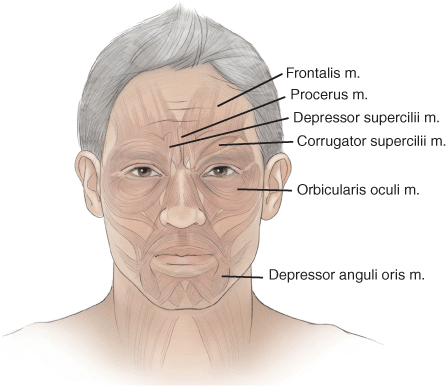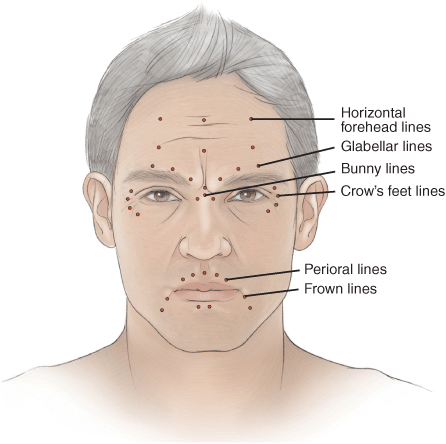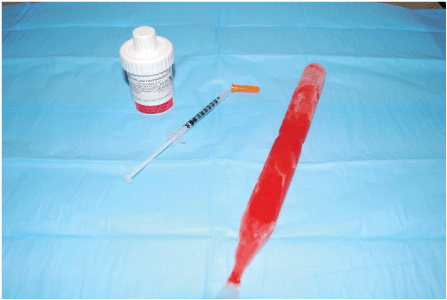Chapter 42. Chemodenervation
Douglas M. Sidle, MD, FACS
INDICATIONS
Injection of botulinum toxin type A is the most common cosmetic procedure performed in the United States. Although Botox (Allergan, Irvine, CA) Xeomin, San Mateo, CA and Dysport (Medicis, Scottsdale, AZ) have FDA approval for cosmetic use in the glabellar lines, it is common practice to use these drugs to inhibit muscle contraction all over the head and neck (Fig. 42-1). Off-label cosmetic indications for the use of botulinum toxin type A include horizontal forehead lines, “crow’s feet,” “bunny lines” on the nose, platysmal bands, and lines the perioral area. Certainly, the most common areas treated with Botox are the glabellar lines, “crow’s feet,” and horizontal forehead lines (Fig. 42-2).

Figure 42-1 Muscles of facial expression that are commonly treated with injectable neurotoxins.

Figure 42-2 Basic injection strategy.
PREOPERATIVE PREPARATION
Botox is supplied in a vial containing 100 U of a vacuum-dried neurotoxin complex. Manufacturer prescribing information recommends reconstitution with 2.5 mL of 0.9% nonpreserved saline, but many treating physicians use different dilutions, ranging from 2.5 to 4.0 mL per vial. Furthermore, preserved saline can be used. Once reconstituted, product efficacy has been shown to last up to 6 weeks if stored at 4°C (39.2°F). Other than standard precautions, no special handling precautions are necessary. Likewise, Dysport is supplied in a vial containing 300 U of neurotoxin complex. It is reconstituted in a similar fashion.
ANESTHESIA
Experienced injectors and patients who have had botulinum injections before may opt to have no anesthesia used during the procedure. However, a more pleasant experience can be offered with the use of a topical anesthetic, particularly in patients sensitive to needles. Topical anesthetic techniques can be as simple as using EMLA (lidocaine 2.5% and prilocaine 2.5%; AstraZeneca, Wilmington, DE) applied for a minimum of 10 minutes prior to the procedure. In our practice we use BLT, a specially compounded cream of 20% benzocaine, 6% lidocaine, and 4% tetracaine. Likewise, ice applied to treatment areas prior to injection can result in reasonable hypesthesia, while reducing the risks of bleeding and ecchymosis. We use frozen popsicles that can be obtained from any grocer (Fig. 42-3).

Figure 42-3 Topical anesthetic and ice can be used to improve patient comfort.
POSITION AND MARKINGS
Because of the risk of a vasovagal syncope during any procedure, patients are treated in either a sitting or recumbent position. No markings are necessary.
DETAILS OF PROCEDURE
Stay updated, free articles. Join our Telegram channel

Full access? Get Clinical Tree








